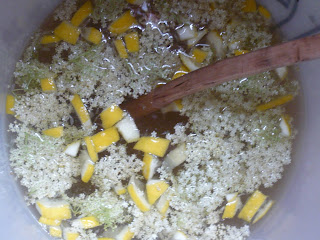"a hip addition to the kitchen shelf"
James Ramsden’s Small Adventures in Cooking recounts exactly that: a mini-voyage of culinary exploration, through Corner Shops and Cheap Cuts, Emulsions and Macerations. Small they may be, but our adventurer is intrepid, unflawed by the likes of Ox cheek or Duck Rilletes, unflailing faced with the Korean fermented cabbage dish, Kimchi, or soused Mackerel. Convivial and colourful from the outset, the reader is swiftly drawn in, to venture alongside Ramsden in this culinary foray.
Separated into eight unorthodox sections, Ramsden writes food as he thinks it: from Va Va Voyages, where you’ll find the exotic and quick to cook, to Corner Shop Capers, a eulogy to the quirky ingredients available in city corner-shops, including Soviet Salmon Soup and a Pitta Pizza topped with the unlikely Tinned Fried Onions(!). Morning Missions is dedicated to breakfasting, suggesting Home-Made Baked Beans, Huevos Rancheros and Chilli Hot Chocolate as additions to the breakfast table. Being a devotee to the art of breaking the fast myself, this quite won me over. Exploring the Cheap Cuts; Formal Forays and Feeding the Flocks are self-explanatory. The latter I found vaguely disappointing, although the food is fun – kebabs, fondues – it has the feel of pub platters. That said, the Goat Curry had me swooning, as Ramsden writes: “Curry is a great party-dish”, to be stacked on rice and served with a multitude of chutneys, raitas and home-made breads. And, I cannot but triumph a cookery book that includes a chapter on Preserves for the Pantry, particularly one that suggests how to use them, saving each of us from that tendency of filling the pantry, only to find same preserves festering on the top shelves years later. Finally, in Surfing the Stumbling Blocks he tackles those notions that tend to terrorise the novice cook: from Shortcrust Pastry to Hollandaise, smartly rendering the seemingly impossible, possible.
The introduction sets the tone for the book: “Surely the kitchen should be a place of comfort and reassurance, not terror and torment”. A voice at once personable and exuberant accompanies the reader; hip without being daunting, it offers guidance without preaching. The recipes are succinct but comprehensive, couched in tips and tales, ever reminding the reader that cooking is a joyous experiment, recipes are: “a guide, not a gospel”. Intrinsic to this is the very malleability of the recipes, all to be “tweaked”, “tarted”, the leftovers used “tomorrow”, spawning same flexibility in the novice-cook, and this is surely one of the hardest kitchen arts for the unexperienced, unadventurous soul, so Ramsden writes: “Trust your instincts”, “Have an amenable agenda” and “Make your itinerary flexible”.
One of the most pertinent mantras of the book: “Keep your ear to the ground” encourages the reader to “Be Chatty” reminding us that cooking is a communal act that commences with sourcing the produce and culminates in that most profound and joyous of communions, the sharing of food. Talk to the shopkeepers, he writes, “as well as making for great entertainment, such discussions are inspiring reminders that there are very few absolutes in cooking”. In this tone, Ramsden recalls an encounter with a “bonkers polish man” who introduced him to an apparently tasty Tinned Sorrel Soup with a Boiled Egg. He takes this interaction one step further by inviting responses to his recipes via Twitter and Email, reminding us that cookery is an art to be explored and above all to be shared
Much as one might pretend otherwise, a cookery book is no longer simply a manual, it has a secondary function: it must induce pleasurable browsing, preferably with a glass of wine in the hand whilst dreaming-up next week’s banquets. This is a beautiful book, quite the sort to curl up on the sofa with. And, a stencilled card and gaudy orange binding, sumptuous photos and near-scrawling notes on carnet-like pages, it proves a hip addition to the kitchen shelf!
Aimed at an audience of twenty or thirty-somethings, the book is far from highbrow, it does not indulge in the literary meanderings of an Elizabeth David, nor for that matter is it a scientific tome. So intent is the writer on keeping the kitchen a light-hearted place, a gentle colloquialism verges on (and happily fails to fall into) the Jamie Oliver tendency of catchphrasing: expressions such as “you get the idea” might put some off, and the book would perhaps be unsuited to the culinary snob.
I say this, and yet, written with such flair, so abounding in joy, and such an utter pleasure to read, I wouldn’t hesitate to pass it on to any of my entourage.
A cook-book that combines a boy-next-door charm and lack of pretension, with an erudite wealth of culinary knowledge, an evident depth of research and recipes destined to please multiple pallets on myriad occasions, with his Small Adventures in Cooking, James Ramsden heralds an exciting new generation of cookery writing.
....
Small Adventures in Cooking by James Ramsden








